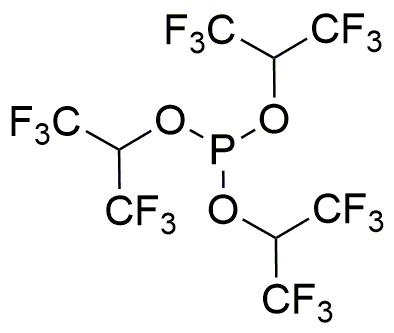Tris(1,1,1,3,3,3-hexafluoro-2-propyl) phosphite is widely utilized in research focused on:
- Flame Retardants: This compound serves as an effective flame retardant in various materials, particularly in electronics and textiles, enhancing safety by reducing flammability.
- Stabilizers in Polymers: It is used as a stabilizer in polymer formulations, providing improved thermal and oxidative stability, which is essential for prolonging the lifespan of plastic products.
- Pharmaceuticals: The compound finds application in the pharmaceutical industry as an intermediate in the synthesis of various drug compounds, aiding in the development of effective medications.
- Coatings and Sealants: It is incorporated into coatings and sealants to enhance their resistance to heat and chemicals, making them suitable for harsh environments in industrial applications.
- Research and Development: In laboratories, it is utilized in the synthesis of new materials and compounds, particularly in studies focused on fluorinated chemicals and their properties.
General Information
Properties
Safety and Regulations
Applications
Tris(1,1,1,3,3,3-hexafluoro-2-propyl) phosphite is widely utilized in research focused on:
- Flame Retardants: This compound serves as an effective flame retardant in various materials, particularly in electronics and textiles, enhancing safety by reducing flammability.
- Stabilizers in Polymers: It is used as a stabilizer in polymer formulations, providing improved thermal and oxidative stability, which is essential for prolonging the lifespan of plastic products.
- Pharmaceuticals: The compound finds application in the pharmaceutical industry as an intermediate in the synthesis of various drug compounds, aiding in the development of effective medications.
- Coatings and Sealants: It is incorporated into coatings and sealants to enhance their resistance to heat and chemicals, making them suitable for harsh environments in industrial applications.
- Research and Development: In laboratories, it is utilized in the synthesis of new materials and compounds, particularly in studies focused on fluorinated chemicals and their properties.
Documents
Safety Data Sheets (SDS)
The SDS provides comprehensive safety information on handling, storage, and disposal of the product.
Product Specification (PS)
The PS provides a comprehensive breakdown of the product’s properties, including chemical composition, physical state, purity, and storage requirements. It also details acceptable quality ranges and the product's intended applications.
Certificates of Analysis (COA)
Search for Certificates of Analysis (COA) by entering the products Lot Number. Lot and Batch Numbers can be found on a product’s label following the words ‘Lot’ or ‘Batch’.
*Catalog Number
*Lot Number
Certificates Of Origin (COO)
This COO confirms the country where the product was manufactured, and also details the materials and components used in it and whether it is derived from natural, synthetic, or other specific sources. This certificate may be required for customs, trade, and regulatory compliance.
*Catalog Number
*Lot Number
Safety Data Sheets (SDS)
The SDS provides comprehensive safety information on handling, storage, and disposal of the product.
DownloadProduct Specification (PS)
The PS provides a comprehensive breakdown of the product’s properties, including chemical composition, physical state, purity, and storage requirements. It also details acceptable quality ranges and the product's intended applications.
DownloadCertificates of Analysis (COA)
Search for Certificates of Analysis (COA) by entering the products Lot Number. Lot and Batch Numbers can be found on a product’s label following the words ‘Lot’ or ‘Batch’.
*Catalog Number
*Lot Number
Certificates Of Origin (COO)
This COO confirms the country where the product was manufactured, and also details the materials and components used in it and whether it is derived from natural, synthetic, or other specific sources. This certificate may be required for customs, trade, and regulatory compliance.


